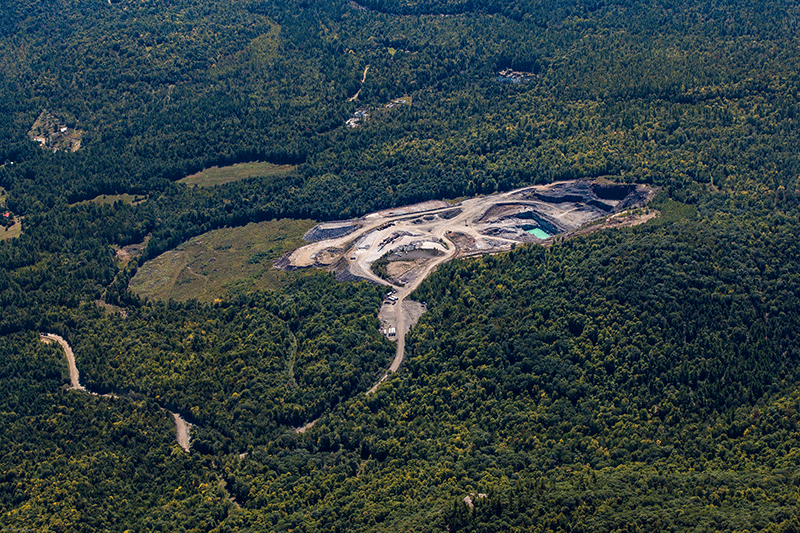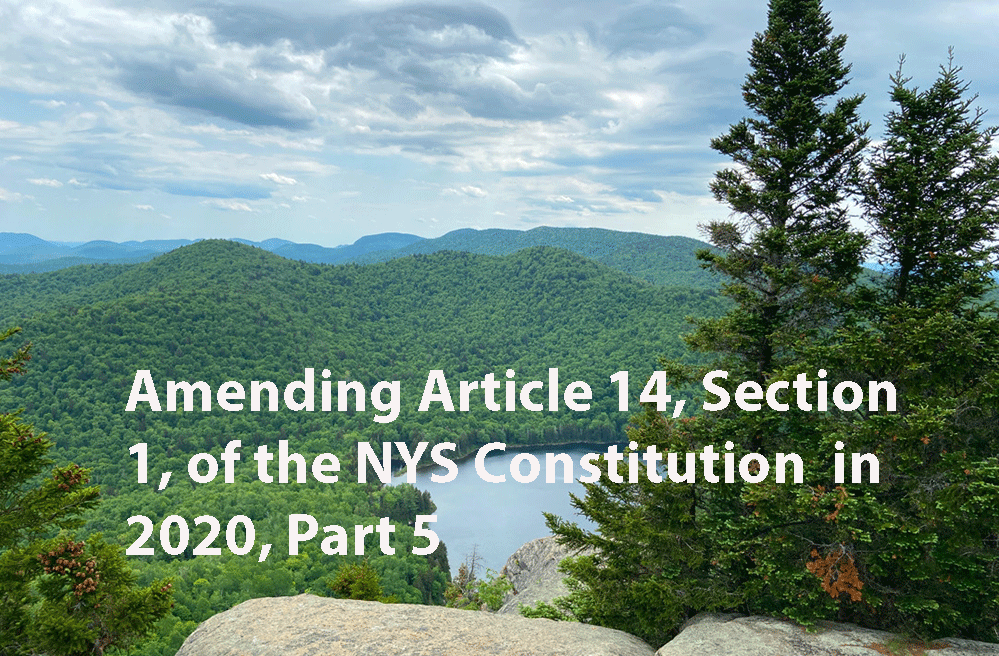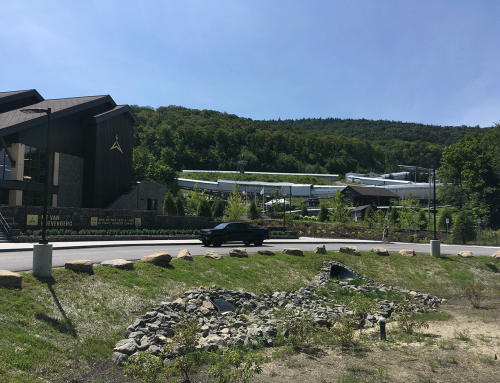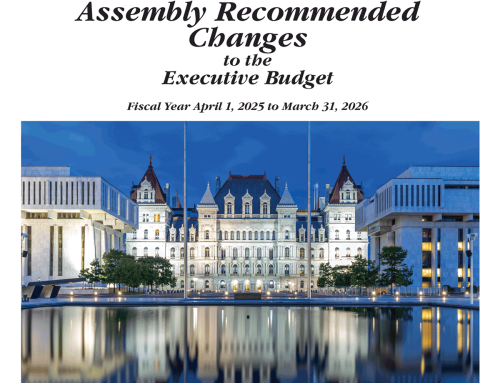This is the last article in a 5-part series on possible amendments in 2020 to Article 14, Section 1, of the NYS Constitution, the famed forever wild provision. This article looks back at the amendment for NYCO Minerals, Inc., in 2013, that authorized exploratory drilling on 200 acres in Lewis Lot 8 in the Forest Preserve in the Jay Mountain Wilderness. This amendment was barely approved, passing by the narrowest margin of any successful Article 14 amendment. The NYCO Amendment was different from all other amendments to Article 14 because it marked the first time that a private corporation used the amendment process to seek and obtain Forest Preserve lands for no other purpose than benefitting its bottom line. Every other amendment had a public benefit and purpose. The NYCO Amendment did not.
The first article in this series outlined the history of Article 14 amendments in recent decades. The second article in this series will focus on the Mt. Van Hoevenberg Olympic Winter Sports Complex managed by the Olympic Regional Development Authority. The third article looked at the issues involved in moving Camp Gabriels off of the Forest Preserve. All of these amendments are in the early stages of development. A fifth will look at the passage of the NYCO amendment, which raised serious questions about public accountability. The fourth article surveyed the complexities of an amendment for Cathead Mountain where Hamilton County aims to build an emergency communications tower.
In the run-up to Second Passage in the Legislature and the statewide vote in the fall of 2013, it was clear to us that NYCO’s supporters were playing fast and loose with the facts. Proponents were cavalier in their claims that if the amendment did not pass, NYCO would leave the state and 150 jobs in Willsboro and Lewis in Essex County would be lost. NYCO had to get access to the Forest Preserve, proponents said, because its only other option would be to open an environmentally damaging new mine. Here’s theHere’s the Department of Environmental Conservation (DEC) Commissioner at the time arguing that NYCO “indicates that defeat of the amendment will cause it to either shift its mine to other Essex County property that it owns or entirely shut down its New York State operations. Mining other NYCO property would result in significantly greater environmental disruption, involving more earthmoving and expensive extraction methods than would be required by mining Lot 8 because the wollastonite vein is deeper in the earth and interspersed with more rock.”
First, in a phone call with the NYCO CEO Peter Goodwin in 2012, in which a representative of Protect the Adirondacks participated along with other green groups as well as DEC staff, the NYCO CEO stated affirmatively that a no vote would not result in NYCO leaving New York. Goodwin said mining Lot 8 would be a “competitive advantage” for the company, which is a far cry from closing down.
Second, proponents never acknowledged that NYCO had a second mine at Oak Hill, less than two miles away from the Lewis mine that borders the Jay Mountain Wilderness (see picture above). The Oak Hill Mine had been fully permitted in the late 1990s, was fully opened with vast amounts of removed overburden, expanded with new permits in the 2000s, and was fully operational. In fact, NYCO had leased out that mountain for nearly 15 years to a company that had removed vast amounts of the overburden on the mountain for its rock and gravel operations, leaving open veins of wollastonite clearly exposed. A 2006 “25 Year Plan” submitted by NYCO to the Adirondack Park Agency (APA) as part of an application for new permits stated that the wollastonite was of a higher grade at Oak Hill than the Lewis Mine and the company intended to transition to Oak Hill. The existence of this plan was never mentioned by NYCO or the proponents of an amendment.

A picture of the two mines owned by NYCO Minerals, Inc. In the foreground is the Oak Hill Mine. In the background is the Lewis Mine, which borders the Jay Mountain Wilderness Area.
DEC published a 19-page PR piece in support of the NYCO amendment that showcased possible lands that could be purchased as compensation for Lewis Lot 8, repeated the misinformation that failure of the amendment will lead to NYCO closing down, and never mentioned the existence of the second mine at Oak Hill, while warning of environmental damage elsewhere in the county if NYCO somehow had to find a new mine.
Events since 2013 have clearly shown that these claims were not truthful because NYCO sought and received new permits from the APA to expand both its Lewis and Oak Hill mines. The Lewis Mine received new APA permits for expansion in two directions away from Lewis Lot 8, mining opportunities that were somehow never addressed by proponents in 2012 or 2013.
Since 2013, despite the approval of the amendment, NYCO was sold to Imerys, a multi-national mining conglomerate. NYCO has let go of more than half of its staff and cut wages for those who remain. Today, NYCO is also principally working out of the Oak Hill mine.
While it was clear that state leaders played fast and loose with the facts around the NYCO votes in the Legislature and the popular vote, what was stunning was information that was forced out long after the dust settled through a Freedom of Information request for all documents and correspondence related to the NYCO deal. From this information, it was clear that the Department of Environmental Conservation (DEC) and Cuomo Administration not only strongly supported the NYCO amendment, but that the DEC, New York’s lead environmental agency, acted as a de facto private lobbying firm, strategic consultant, and research firm to provide materials and guidance that decisively aided NYCO’s legislative and PR campaigns during legislative action and the public vote. Below, we detail how the DEC acted as a private lobbyist, where a number of DEC staff worked on NYCO’s behalf. It’s important to note that while some information was released in this information request, vast amounts of internal state agency and DEC correspondence was withheld.
DEC Invested Prodigious Staff Time in Developing Promotional Materials
During First and Second Passage in the Legislature, DEC representatives reached out to legislators, legislative staff, and various interest groups urging their support for the NYCO amendment. Certainly, the DEC has a role in decisions made regarding the Forest Preserve, which is under its care and custody, but it was unusual for the DEC to take the lead in drafting and selling an Article 14 amendment. The DEC did not actively lobby other Article 14 amendment, like it pushed the NYCO amendment.
DEC staff took the unusual steps of developing “fact sheets” and “talking points” in support of the NYCO amendment. In the talking points that DEC sent to legislative staff, DEC talks about buying 2,000 acres at $500 an acre in exchange for Lewis Lot 8. Really? $500 an acre? In Essex County?
This fact sheet also talks about “superior” natural resources of new lands versus the mature, near-old-growth forests that had been in the Forest Preserve since the 1890s in Lewis Lot 8. According to the DEC, the mature forests on Lot 8 “had no particular natural resource value.” It’s remarkable, to say the least, to see the lead environmental agency in New York turn its nose down on 200 acres of forests that had not been logged or otherwise disturbed for at least 120 years. This all culminated in DEC’s 19-page “position paper” in May 2013 boosting the NYCO amendment.
We can quibble with the statements that the DEC makes in these various lobbying materials, but we should all be concerned when a state agency invests prodigious amounts of staff time in the development of materials for the principal benefit of a private corporation, or as the NYCO CEO stated, to assist the corporation’s “competitive advantage.” This level or DEC lobbying and development of supplemental materials was unprecedented.

An aerial of the Lewis Mine. The border line with the public Forest Preserve is evident as it runs straight along the wall of the open pit mine at the top of the picture.
DEC Actively Lobbied Non-Profit Groups in Support of NYCO Amendment
DEC’s lobbying of environmental groups was also unprecedented. DEC routinely held sessions with more than a half dozen DEC staffers at a time with the Adirondack Mountain Club, Adirondack Council, Adirondack Wild, Protect the Adirondacks, the Sierra Club and Environmental Advocates, among others. In 2012, the Adirondack Council opposed the NYCO amendment, but DEC was able to get the organization to reverse its decision and endorse the amendment in 2013. In 2012, Environmental Advocates opposed the NYCO amendment. DEC staff emailed to Environmental Advocates “We are of course disappointed that you have chosen to oppose and memo the NYCO proposal.” In 2013, DEC was able to get EA to take no position on Second Passage. In 2012, DEC worked on the Adirondack Mountain Club, which supported the amendment.
DEC reached out far and wide. DEC’s lead lobbyist reached out to the NYS Business Council, about the NYCO amendment writing “You around to discuss? We’re hoping for some help.” DEC staff reached out to try and enlist support from the NY League of Conservation Voters and The Nature Conservancy.
DEC’s also worked the Sierra Club, Atlantic Chapter, to support the NYCO amendment. The hard sell led the Sierra Club leader Roger Downs to write to the DEC “I’ve had a few days to process our meeting and I appreciate the follow up. Clearly the NYCO deal is of great importance to DEC as is evident by the amount of staff outreach. Admittedly this level of focus is curious to me in consideration of the universe of other issues facing DEC.”
In the end, DEC successfully enlisted the support of a few groups, which helped pass this amendment in the Legislature and during the public referendum. In no other amendment did the DEC whip the votes of environmental groups like it did to build support for the NYCO amendment.
DEC Guided, and Coordinated with, NYCO in Lobbying and Advocacy
Beyond developing promotional materials and pressuring environmental groups to support the NYCO amendment, DEC counseled NYCO staff and its lobbyists on who and when to lobby individual legislators and how to successfully build a coalition. State agency staff counseling private corporations on strategies to help with legislative success seems out of the ordinary, or at least it should be.
After the success of First Passage of the NYCO amendment in 2012, that fall supporters started planning for joint operations in 2013 for Second Passage. In November 2012, staff for Assemblymember Teresa Sayward reached out to the DEC with a request, “NYCO is looking for talking points for the video they are preparing to make.” DEC responds to the NYCO CEO “Hope you had a nice Thanksgiving. Attached is what DEC has developed for talking points in follow up to our meeting. My apologies for the delay. Rob [Davies] will be reaching out to set up a conference call to discuss next steps. Please let me know if you have any questions, comments or concerns. Thank you. Julie [Tighe].”
DEC continued to work with NYCO on securing some undeveloped NYCO lands for potential parts of the land swap. DEC asks for “verbiage” and “property descriptions.” DEC also worked with NYCO on its overall strategy. At 3:05 PM on April 30, 2013, Davies wrote NYCO CEO Goodwin: “Peter, Any word on the steel workers?” in reference to political/lobbying support from the Steelworkers Union. At 3:34, Goodwin responded to Davies: “You must be clairvoyant! Just heard that we will get Steelworker support. Does Julie T [Tighe] have a Bill number yet? So we can pass to the Steelworkers.” At 3:47 PM, Tighe emailed Goodwin and asked for a bill memo from the Steelworkers Union in support of the NYCO amendment: “Please ask the steelworkers union to get us their memo when it is available and we can see if we can leverage that.”
In May, Mark Behan of Behan Communications, retained by NYCO for lobbying and public relations, emailed back and forth with Tighe about memos of opposition. On May 15, Behan emailed DEC leaders transmitting a letter of support for the NYCO amendment from Congressman Bill Owens to Assembly Speaker Sheldon Silver and said he “looked forward to talking on Monday.”
On May 24, 2013, Goodwin, Behan and DEC leaders exchanged emails and materials for a conference call later that day. Behan Communications had prepared various lobbying materials that would be previewed in that call. On May 31, 2013, Goodwin emailed DEC seeking guidance for how to lobby the Legislature. Tighe emailed back with precise targets for who to lobby: “More specifically, the chair of the En Con Committee and central staff.”
On June 3rd, Tighe wrote Goodwin reporting of progress in the Legislature: “We had a good meeting today with Assm Stec and Senator Little to bring them up to speed on where things are. The Commissioner and I are meeting w Assm Sweeney [Assembly Conservation Committee Chair Robert Sweeney] tomorrow to fill them in. I am in the process of scheduling meetings with … other environmental groups for later this week. Thanks-Julie.” At 4:50 PM that day, Behan emailed Tighe and others at DEC about the support of the Steelworkers Union: “Dear Rob, Julia, Marc and Ken — Enclosed is the United Steelworkers’ letter issued today to Assembly Speaker Silver (and copied to Gov. Cuomo, Commissioner Martens, Sen. Little and all members of the Assembly) endorsing the NYCO Adirondack land exchange. Best regards, Mark Behan.” Thirteen minutes later, Tighe responded “Fantastic. Thanks!” Davies responded at 6:20 PM, “Excellent. We are making real progress at the right time. Thanks.” The next day Goodwin emailed Davies and Tighe a memo of support from the ALF-CIO.
On June 12, 2013, Tighe emailed retired Assemblymember Sayward “Thanks for your efforts. Please let me know if there are particular members you think need me to pay them a visit. I’m going to try and hit up en con and judiciary members today. Thanks- Julie”. Sayward wrote later: “Hi Julie, I have been on the phone this morning and I too believe the Judiciary is important. I will meet personally with Helene [Assemblymember Weinstein] this coming week. She may not vote for the bill, but I believe she will work with me to get it through committee. Teresa.”
At 9:32 PM on June 12th, Tighe emailed Mr. Goodwin reporting that Assembly Environmental Conservation Committee chairman Robert Sweeney had put the bill for Second Passage on his committee’s calendar. She suggested that NYCO submit a letter in support: “i think you guys should submit a memo/letter to the various committees. assm en con, judiciary and W&M. plus the speaker.” Five minutes later, Goodwin responded needing clarification and guidance: “Julia What. Type of letter and Please list who? Mark Behan can draft one Regards Peter.” Six minutes after that, Tighe emailed Goodwin “letter of support explaining why its important to the company. all the dem members of the assembly en con, judiciary and ways & means committees – mark behan should know how to get those lists. Its a lot of members in the Assm. (I know b/c i have been pulling them off the Assm floor all day today to discuss this with them).” At 9:46 PM, Goodwin responded “How about giving them the Video? A letter will take time” and also asking Tighe “How much time do we have?” At 9:48 PM, Tighe emailed “En con is tomorrow. Not sure when the next cmte mtgs will be – likely next week.” At 9:51, Goodwin responded “Thanks I’ll talk to Mark [Behan] in the AM.” At 9:51 PM, Tighe emailed “Sounds good.”
Now, understand, that it takes six months for the DEC to respond to a simple Freedom of Information request. Clearly, NYCO got some pretty great service from senior DEC staff. The correspondence above, and the coordinated materials, shows a vast expenditure of state resources on behalf of NYCO Minerals, Inc., as well as a hand-in-glove coordination between the corporation and the DEC to plan and execute a legislative campaign. This unprecedented support by the DEC was decisive in passing this amendment in the Legislature.

An aerial of NYCO’s Oak Hill Mine. Supporters pretended that this mine did not exist and was not operational in 2013. The Oak Hill Mine was approved in the late 1990s and was fully operational in 2013.
DEC Intervened at the Board of Elections to Change Ballot Language to Make it Favorable to NYCO
As it turned out, the DEC’s work in support of NYCO did not end with the Second Passage in June 2013. The DEC’s work to support the NYCO amendment was needed again, and acutely, in August. At 6:31 AM on August 1, 2013, Behan emailed his team at Behan Communications and NYCO leaders about the ballot language approved by the Board of Elections at its July 29, 2013 meeting.
Dear Colleagues:
We have received word from New York State Board of Elections that the NYCO and land swap amendment will be Proposition Number 5 on the November ballot. In addition, the Board of Election has proposed the following language:
In Relation to a Land Exchange in the State Forest Preserve with NYCO Minerals, Inc.
The proposed amendment to section 1 of article 14 of the Constitution would authorize the Legislature to convey forest preserve land located in the town of Lewis, Essex County, to NYCO Minerals, a private company that plans on mining the land. In exchange, the NYCO Minerals would give the State at least the same amount of land of at least the same value, with a minimum assessed value of $1 million, to be added to the forest preserve. When NYCO Minerals finishes mining, it would restore the condition of the land and return it to the forest preserve. Shall the proposed amendment be approved?As you can see, the language is inaccurate, unclear and clumsy. For example: NYCO has committed to giving the state at least 1,500 acres of land. It does not make clear that the state’s transfer of 200 acres to NYCO is temporary, while additions to the state forest preserve are permanent. While NYCO and mining are mentioned twice, the language never expresses the public benefit of the exchange: More open space for preservation and recreation. (Other proposed amendments do set forth such a benefit, as shown below.) We are working with our contacts in state government to see if the Board of Elections can be persuaded to make changes in the language and will have more to report on Monday.
At 11:58 AM on August 1, 2013, Mr. Goodwin emailed Davies and Marc Gertsman, DEC Counsel, conveying NYCO’s unhappiness with the Board of Elections’ approved language. “Rob, I will call you this PM around 1:00. We are VERY concerned with this language. See below [Behan’s forwarded email]. Regards Peter.” At 1:12 PM, Tighe responded to Goodwin: “we are doing what we can on this.”
Assemblymember Dan Stec’s chief of staff Deb Capezzuti emailed Tighe with recommended ballot language from Behan Communications:
Mark Behan reached out to us with proposed language for the ballot-Mark feels that the revised language still references mining to often and also referring to NYCO as a private company. He also suggested changing the word “assessed” to “appraised” but the CA bill clearly states “assessed”, which we need to be consistent with- as you can see he wants to include the 1500 acres which I don’t think we can do as it is not mentioned in the CA in that manner. I do like the terminology “for mineral exploration and extraction in exchange for”. Elizabeth said that DEC and Assembly signed off on this yesterday which we were not aware of-I was off last Thursday and Friday. Please let me know your thoughts-thanks Deb. Below is Behan’s suggestion:
Behan’s suggestion:
The proposed amendment to Section 1, Article 14 of the State Constitution would authorize the Legislature to temporarily convey to NYCO Minerals Inc. 200 acres of forest preserve land in the Town of Lewis, Essex County, for mineral exploration and extraction in exchange for which NYCO Minerals Inc. would permanently convey to the state at least 1,500 acres to expand and improve public access to the forest preserve and would fully restore the condition of the borrowed 200 acres and return it to the forest preserve? Shall the amendment be approved?
–Deb Capezzuti Chief of Staff Office of Assemblyman Dan Stec.”
On August 5, 2013 the Board of Elections executive staff changed the ballot language for Proposal 5. The July 29, 2013 version approved by the Board of Elections Commissioners themselves reads:
Proposition 5 In Relation to a Land Exchange in the State Forest Preserve with NYCO Minerals, Inc.
The proposed amendment to section 1 of article 14 of the Constitution would authorize the Legislature to convey forest preserve land located in the town of Lewis, Essex County, to NYCO Minerals, a private company that plans on mining the land. In exchange, the NYCO Minerals would give the State at least the same amount of land of at least the same value, with a minimum assessed value of $1 million, to be added to the forest preserve. When NYCO Minerals finishes mining, it would restore the condition of the land and return it to the forest preserve. Shall the proposed amendment be approved?
The August 5, 2013 version approved by the Board of Elections executive staff and placed on the ballot reads (changed language is in bold):
Proposition 5 In Relation to a Land Exchange in the State Forest Preserve with NYCO Minerals, Inc.
The proposed amendment to section 1 of article 14 of the Constitution would authorize the Legislature to convey forest preserve land located in the town of Lewis, Essex County, to NYCO Minerals, a private company that plans on expanding an existing mine that adjoins the forest preserve land. In exchange, NYCO Minerals would give the State at least the same amount of land of at least the same value, with a minimum assessed value of $1 million, to be added to the forest preserve. When NYCO Minerals finishes mining, it would restore the condition of the land and return it to the forest preserve. Shall the proposed amendment be approved?
In response to a press inquiry related to the six ballot amendments and to a controversy around the language of the proposed gambling amendment, the Board of Elections staff stated in pertinent part that “The Department of Environmental Conservation asked for changes to the two Adirondack land swap amendments which were accommodated and re-certified and co-signed by the two Co-Executive Directors on August 5. No changes were made to the other amendments after the July 29th meeting.” It’s important to note that Protect the Adirondacks was denied additional materials under a Freedom of Information Request by the Board of Elections, including 45 pages of correspondence with other state agencies. An appeal of this decision was also denied.
Once again, this level of intervention by senior DEC staff on behalf of NYCO was unprecedented. These 45 pages of withheld materials should be made public.
DEC Assisted NYCO in its Vote Yes Advocacy for November 2013 Election
The coordination between the DEC and NYCO did not end with Second Passage or the intervention at the Board of Elections. DEC assisted NYCO with its promotion of Proposal 5 in the run-up to the November 5, 2013 election.
On June 20, 2013, at 2:47 PM, just a day after Second Passage, NYCO started organizing for its advocacy campaign for the general election. It started with a request to DEC for help. Dan Fitzgerald, of Behan Communications, wrote Davies and Tighe asking for lobbying materials that DEC had developed for use in advocating in the general election. Fitzgerald wrote:
Rob, After reading the DEC position paper, I was impressed with the detail that it provided as well as with the fact that it showed the use of the Adirondack Council guidelines. I think that this would be a wonderful resource for interested voters who will want to be informed before casting their vote on this issue. I thought that if the position paper were already posted to the DEC website, we could simply provide people with the link. In the event that it is not or will not be posted there, is this document one that can be shared on supporters websites? Dan Fitzgerald, PMP, Senior Project Manager, Behan Communication.
Davies responded that day: “Hi Dan – No, we never put maps on the DEC website. We would be happy to e-mail to you whatever you need that would assist you in creating a website. Let me know if you need anything.”
On August 26, 2013, Goodwin emailed Tighe and Davies about a new promotional website and Facebook page supporting Proposal 5.
At 9:16 AM on October 16, 2013, Behan emailed Goodwin seeking help to refute criticisms of Proposal 5: “Hi, Rob, Peter and Mark — Among his frequent criticisms of Proposition 5 Peter Bauer says there’s no enabling legislation — therefore, no guarantee that the state will get what it says it will get. Conversely, he says, there is enabling legislation for Prop. 4. Do you know the history here? Why no enabling legislation? We want to be prepared with an answer. Thanks Mark.” At 9:18 AM, Goodwin forwarded Behan’s email to Tighe and asked “Please see the email below. Can you provide an answer for us on this issue?” At 9:33 AM, Tighe responded to Goodwin and at 10:18 AM Ken Hamm, a DEC attorney, provided a more detailed response. The next day Mr. Goodwin emailed Hamm “Thanks Ken” and to Tighe “Thanks for the help Julie.” Tighe emailed Goodwin “Any time.”
DEC staff should have refrained from any and all advocacy or support for this amendment in the months after Second Passage and prior to the election in November 2013. State agencies are barred from assisting one side or the other in ballot questions. DEC was hardly impartial.
The Fallout
The NYCO Amendment was listed on the 2013 ballot as Proposition 5. It passed, largely carried by strong union efforts in support of Proposition 1 that allowed casino gambling in New York. Hundreds of thousands fewer New Yorkers voted for Proposition 5 than did Proposition 4 for the resolution of property title issues in Township 40 around Raquette Lake.
Since the passage of the amendment in 2013, NYCO has conducted test drilling on Lewis Lot 8, cutting the forest that had not seen an axe since the 1890s, or before, for roads and drilling platforms. NYCO is now working to test the wollastonite supply beneath Lewis Lot 8 by horizontal drilling from its mine wall that borders the Forest Preserve.
The good news is that the NYCO amendment has produced changes in the assessment of proposed Article 14 amendments in the Legislature in several critical ways, spearheaded by the leadership of the State Assembly Conservation Committee Chair Steven Englebright and the senior environmental staff in the State Assembly:
- It is now stated policy among legislative leaders and staff that a proposed Article 14 amendment must be scrutinized for its purpose and benefits. An amendment must be a verifiable solution of last resort that is needed to resolve a real public problem.
- An amendment must provide tangible public benefits.
- An amendment must be written consistent with past amendments.
- An amendment must be accompanied by enabling legislation that details all agreements and the process for how the amendment will be administered at the time of First Passage. Enabling legislation is now a must for Article 14 amendments.
The three possible amendments at varying stages of consideration in 2020 are being assessed under this criteria. While State Assembly leaders have made it clear that there will be no more NYCO-style amendments, and that new possible Article 14 amendments will be tightly scrutinized, the DEC and Cuomo Administration have shown no appetite for reflection. Thankfully, the Legislature has made serious reforms.
The NYCO amendment has not been finalized by the Legislature as is required. The final land swap has to be authorized by the Legislature to approve the value of Lewis Lot 8 and the new lands proposed for addition to the Forest Preserve as compensation for the loss of Lewis Lot 8. It’s 2020 and the state has yet to submit anything.
Protect the Adirondacks has called for legislative hearings to fully examine the role of the DEC and Board of Elections in the NYCO Amendment. It is our position that this amendment should not be finalized by the Legislature until all of DEC’s actions in support of NYCO have been brought to light, all withheld materials made public, and that this matter is fully investigated.
In 2015, Protect the Adirondacks submitted a complaint to state leaders about the NYCO amendment. The New York Times published parts of PROTECT’s research.






